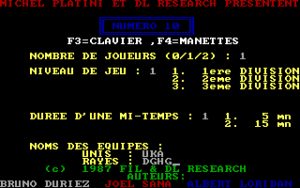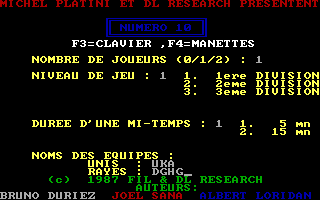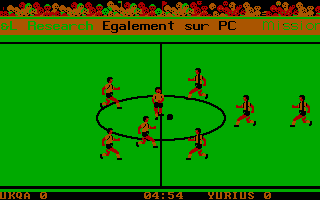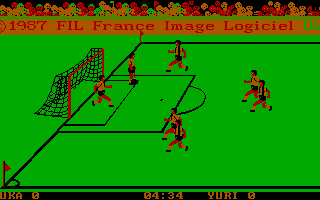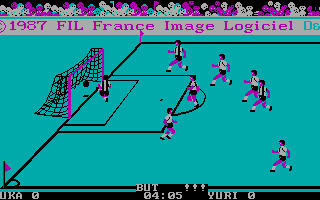Numéro 10 description
Raritetnye PC version of the French (and almost certainly only published in this country) football arcade, until late spring of 2018, which was considered exclusive to a little-known French Thomson computers as unconditional proof of evidence to the contrary was not found. But, as you can see, in fact, it was not quite so - and this game still visited the land of our beloved IBM PC, and at least the external appearance of the port exceeds the original. In other words, Yes, you guessed it: we have before us another rarity, and produced surprisingly quickly after its discovery, but revived - it is here that word - to life at the cost of enormous efforts of several people, because to remove the image virtually unusable floppy and then crack a very cunning and nasty because the copy protection was, well, difficult. But all this is behind us, and Numéro 10 from now on, forever with us and with you.
The name is a reference to the room which was enshrined in the national team for French football legend Michel Platini, who later became a prominent sports official. And, interestingly, in the original version for Thomson in the opening Intro had a portrait of him, while in port not seen anything like it, even on the title screen his name and the name and specified. The right to use personal data to developers and publishers he must have acquired - but it is obvious that any other license here and does not smell, so don't expect any real player names or team names. In fact, this thing even you cannot in any way be attributed to the genre "sports": there are no modes (not counting the "friendly match", though this phrase anywhere in itself is not mentioned), no tactics and, in General, almost no real rules of football as a sport - we are pure arcade.
Before the start is required to consistently choose the number of "live" participants of the future action - zero to two (i.e. you can play with another person with one computer, one or even to start "automatic" match and stay in the role of spectator), difficulty level (from the first division to the third, and, unlike real life, where "class" of the opponent is higher in the third and not in first), the duration of each of the two halves (formally five or fifteen minutes, but the time this is playing, not real, in fact the fight will last about half), and to call both teams (you can enter anything - even numbers or random characters, and both have opponents they can be absolutely identical).
Then starts the match between the teams, each consisting of five players: four field (without any differences in roles, of course) and a goalkeeper. Our team is dressed in a light form (enemy - striped) and at the time of launch always takes the left half of the field. At the end of the first half, the exchange gates, and is one of the few "rules" that have migrated here from real football; the offside, free kicks, penalties, corners, referees, cards, deletions, substitutions, and other joys and sorrows not.
The control is performed using the five keys on the numeric keypad: four arrows responsible for moving the player with the ball (or the nearest to it, if the one controlled by the opponent or anyone not busy), and "5" that meets at the same time - depending on the situation - for the pass, pass, shot on goal, management and other actions. After the start, and if a goal is scored (anyone) both teams line up in the center of the field for "draw" - that is, the beginning or the resumption of the game (which, in principle, also conforms to the rules of football): please note that to strike first (apparently) always needs you, if this is not done, then all players will still be in place and the timer ticking. If the goalkeeper managed to repel the attack, then the same "standing" comes near the gate, and not necessarily to be executed, hitting the goalkeeper, the situation may be different.
The possibility of choosing not to members of the team to pass the ball, not provided: this happens automatically, and - most of all - on the principle of "shortest distance", that is someone who is closest to the current "owner" of the ball, although occasionally athletes are able to submit sufficient long balls of different heights, almost two thirds of the field (but usually running "nowhere"). To control the goalie at any point in time is also impossible - it is available only in the case when the ball is close to him; to beat goals (is responsible for it all the same generic "5") is quite difficult, but possible, to score - and much more difficult, although still too real. However, the purely mechanical the whole process is reduced to a frenetic press that given the not very successful at those responsible for it, is not easy. Opponents are moving very quickly and proficiently, so keep an eye on them "fuss" and even more for moving the ball down the field is also problematic and, worse, may even after some time to get bored.
Note that the level of player depending on the division really is very different, and if the first even with minimal skill you can at least lose with a minimal gap, then the third is likely to lose not just a "dry" (i.e. not allowed to score a single goal), and with the score what a football is almost never (unless you remember the famous match between Australia and American Samoa, although there the result of "outperform" here really). In very rare cases, the game may briefly to "zaglyuchit" when two players face each other - all members of the opposing team stop and start moving again only after a second after you pressed any button.
The graphics, as already mentioned, the DOS version is better "Romanovskoe", although something outstanding she is not even adjusted for the time of release; however, models athletes more or less large and well built (although, of course, "bolvanistye") - and there is even a small picture of the stands with the fans (of course, static). In General - it is arcade, but never a simulator, and complicated due to the primarily objectively poorly implemented controls. And therefore the value of it is mostly a collectible, although fans of challenging games of such a plan (kind of famous in the narrow circles of Street Football) could be like.
Have you ever wondered what kind of video games were played in the good old days? Try playing Numéro 10 online now and we are sure you will not stop playing again.
Source: Archive.org, Mobygames.com
